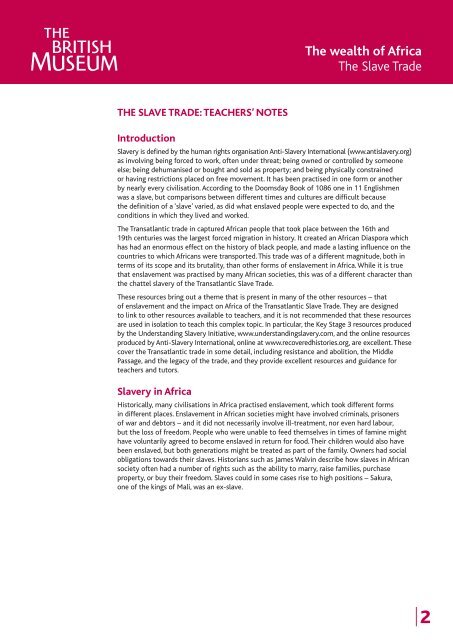The wealth of Africa The Slave Trade - British Museum
The wealth of Africa The Slave Trade - British Museum
The wealth of Africa The Slave Trade - British Museum
Create successful ePaper yourself
Turn your PDF publications into a flip-book with our unique Google optimized e-Paper software.
THE SLAVE TRADE: TEACHERS’ NOTES<br />
Introduction<br />
<strong>The</strong> <strong>wealth</strong> <strong>of</strong> <strong>Africa</strong><br />
<strong>The</strong> <strong>Slave</strong> <strong>Trade</strong><br />
<strong>Slave</strong>ry is defined by the human rights organisation Anti-<strong>Slave</strong>ry International (www.antislavery.org)<br />
as involving being forced to work, <strong>of</strong>ten under threat; being owned or controlled by someone<br />
else; being dehumanised or bought and sold as property; and being physically constrained<br />
or having restrictions placed on free movement. It has been practised in one form or another<br />
by nearly every civilisation. According to the Doomsday Book <strong>of</strong> 1086 one in 11 Englishmen<br />
was a slave, but comparisons between different times and cultures are difficult because<br />
the definition <strong>of</strong> a ‘slave’ varied, as did what enslaved people were expected to do, and the<br />
conditions in which they lived and worked.<br />
<strong>The</strong> Transatlantic trade in captured <strong>Africa</strong>n people that took place between the 16th and<br />
19th centuries was the largest forced migration in history. It created an <strong>Africa</strong>n Diaspora which<br />
has had an enormous effect on the history <strong>of</strong> black people, and made a lasting influence on the<br />
countries to which <strong>Africa</strong>ns were transported. This trade was <strong>of</strong> a different magnitude, both in<br />
terms <strong>of</strong> its scope and its brutality, than other forms <strong>of</strong> enslavement in <strong>Africa</strong>. While it is true<br />
that enslavement was practised by many <strong>Africa</strong>n societies, this was <strong>of</strong> a different character than<br />
the chattel slavery <strong>of</strong> the Transatlantic <strong>Slave</strong> <strong>Trade</strong>.<br />
<strong>The</strong>se resources bring out a theme that is present in many <strong>of</strong> the other resources – that<br />
<strong>of</strong> enslavement and the impact on <strong>Africa</strong> <strong>of</strong> the Transatlantic <strong>Slave</strong> <strong>Trade</strong>. <strong>The</strong>y are designed<br />
to link to other resources available to teachers, and it is not recommended that these resources<br />
are used in isolation to teach this complex topic. In particular, the Key Stage 3 resources produced<br />
by the Understanding <strong>Slave</strong>ry Initiative, www.understandingslavery.com, and the online resources<br />
produced by Anti-<strong>Slave</strong>ry International, online at www.recoveredhistories.org, are excellent. <strong>The</strong>se<br />
cover the Transatlantic trade in some detail, including resistance and abolition, the Middle<br />
Passage, and the legacy <strong>of</strong> the trade, and they provide excellent resources and guidance for<br />
teachers and tutors.<br />
<strong>Slave</strong>ry in <strong>Africa</strong><br />
Historically, many civilisations in <strong>Africa</strong> practised enslavement, which took different forms<br />
in different places. Enslavement in <strong>Africa</strong>n societies might have involved criminals, prisoners<br />
<strong>of</strong> war and debtors – and it did not necessarily involve ill-treatment, nor even hard labour,<br />
but the loss <strong>of</strong> freedom. People who were unable to feed themselves in times <strong>of</strong> famine might<br />
have voluntarily agreed to become enslaved in return for food. <strong>The</strong>ir children would also have<br />
been enslaved, but both generations might be treated as part <strong>of</strong> the family. Owners had social<br />
obligations towards their slaves. Historians such as James Walvin describe how slaves in <strong>Africa</strong>n<br />
society <strong>of</strong>ten had a number <strong>of</strong> rights such as the ability to marry, raise families, purchase<br />
property, or buy their freedom. <strong>Slave</strong>s could in some cases rise to high positions – Sakura,<br />
one <strong>of</strong> the kings <strong>of</strong> Mali, was an ex-slave.<br />
2

















